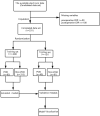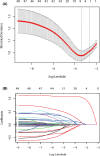Automated machine learning-based model predicts postoperative delirium using readily extractable perioperative collected electronic data
- PMID: 34792857
- PMCID: PMC8928919
- DOI: 10.1111/cns.13758
Automated machine learning-based model predicts postoperative delirium using readily extractable perioperative collected electronic data
Abstract
Objective: Postoperative delirium (POD) is a common postoperative complication that is relevant to poor outcomes. Therefore, it is critical to find effective methods to identify patients with high risk of POD rapidly. Creating a fully automated score based on an automated machine-learning algorithm may be a method to predict the incidence of POD quickly.
Materials and methods: This is the secondary analysis of an observational study, including 531 surgical patients who underwent general anesthesia. The least absolute shrinkage and selection operator (LASSO) was used to screen essential features associated with POD. Finally, eight features (age, intraoperative blood loss, anesthesia duration, extubation time, intensive care unit [ICU] admission, mini-mental state examination score [MMSE], Charlson comorbidity index [CCI], postoperative neutrophil-to-lymphocyte ratio [NLR]) were used to established models. Four models, logistic regression, random forest, extreme gradient boosted trees, and support vector machines, were built in a training set (70% of participants) and evaluated in the remaining testing sample (30% of participants). Multivariate logistic regression analysis was used to explore independent risk factors for POD further.
Results: Model 1 (logistic regression model) was found to outperform other classifier models in testing data (area under the curve [AUC] of 80.44%, 95% confidence interval [CI] 72.24%-88.64%) and achieve the lowest Brier Score as well. These variables including age (OR = 1.054, 95%CI: 1.017~1.093), extubation time (OR = 1.027, 95%CI: 1.012~1.044), ICU admission (OR = 2.238, 95%CI: 1.313~3.793), MMSE (OR = 0.929, 95%CI: 0.876~0.984), CCI (OR = 1.197, 95%CI: 1.038~1.384), and postoperative NLR (OR = 1.029, 95%CI: 1.002~1.057) were independent risk factors for POD in this study.
Conclusions: We have built and validated a high-performing algorithm to demonstrate the extent to which patient risk changes of POD during the perioperative period, thus leading to a rational therapeutic choice.
Keywords: delirium; machine learning; model prediction; nomogram; postoperative.
© 2021 The Authors. CNS Neuroscience & Therapeutics published by John Wiley & Sons Ltd.
Conflict of interest statement
The authors declare that they have no competing interest.
Figures




References
Publication types
MeSH terms
LinkOut - more resources
Full Text Sources
Medical

